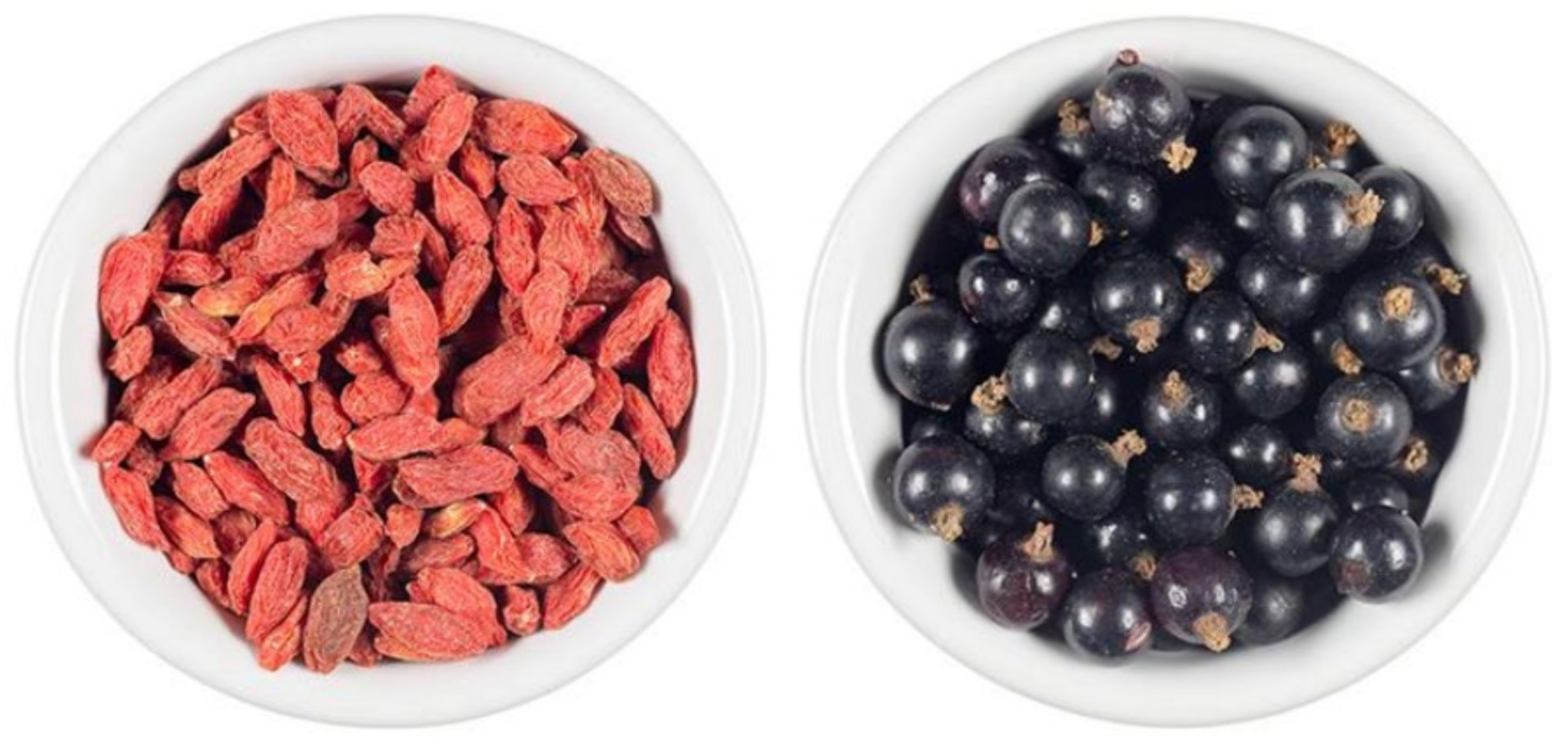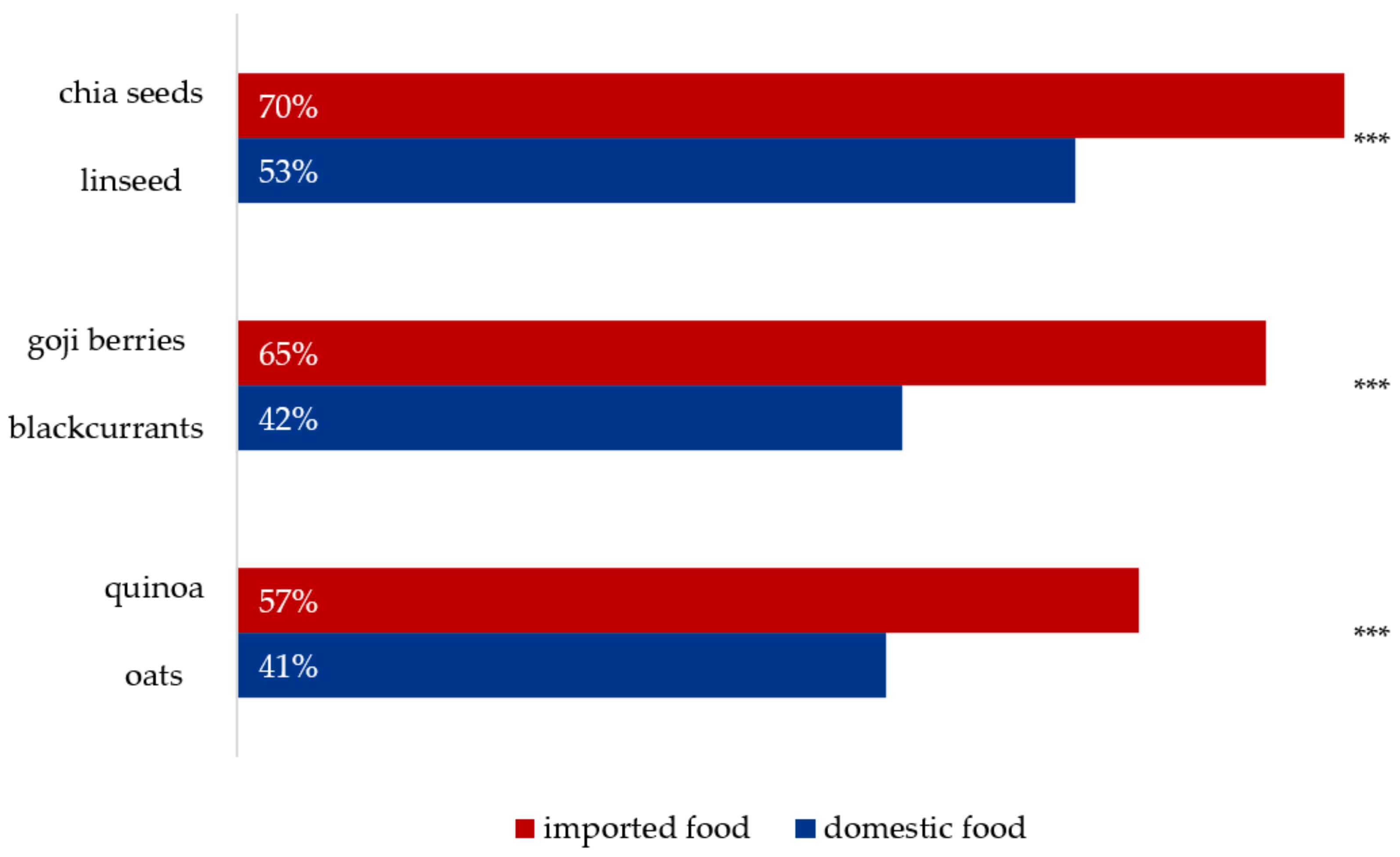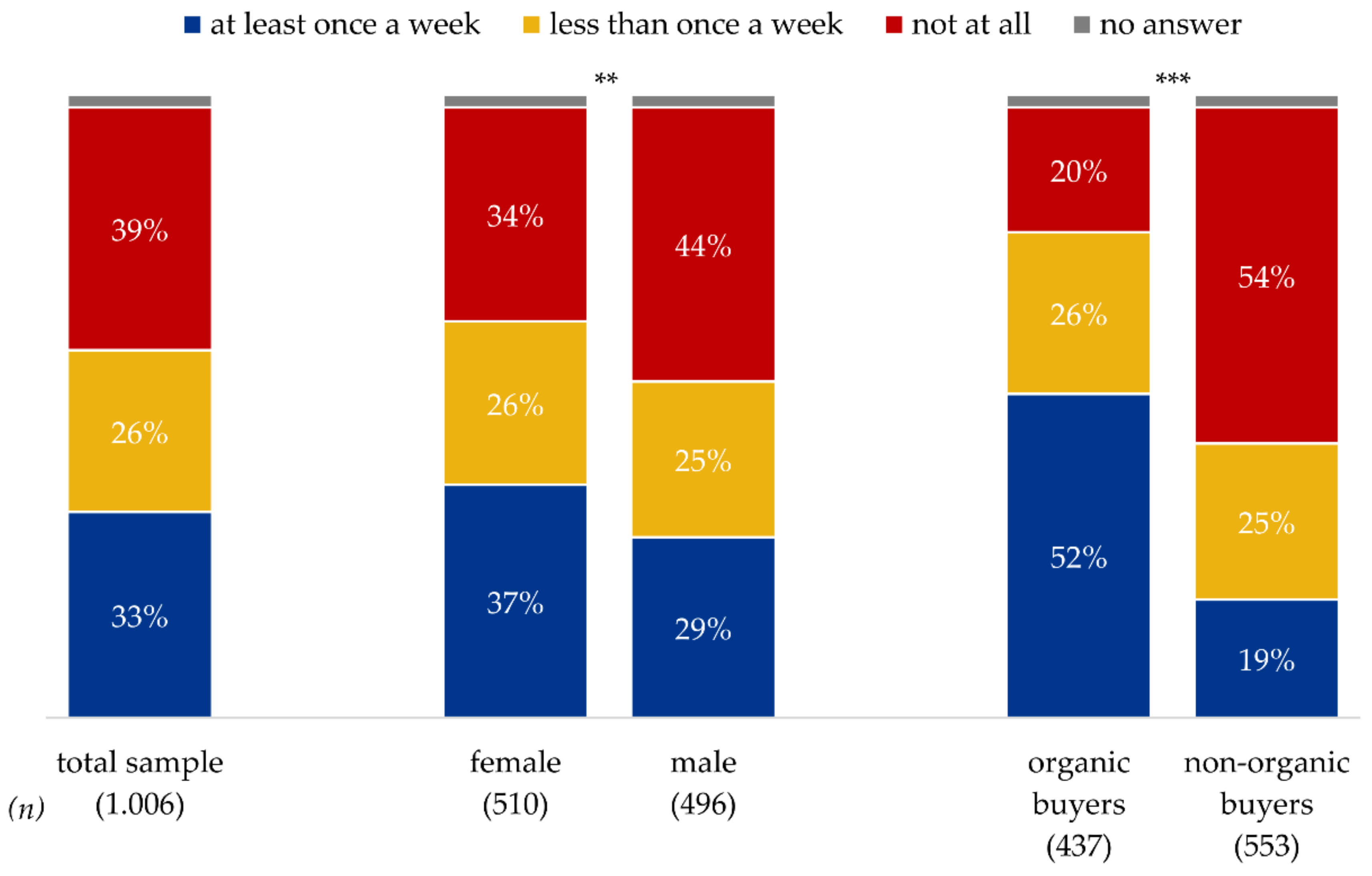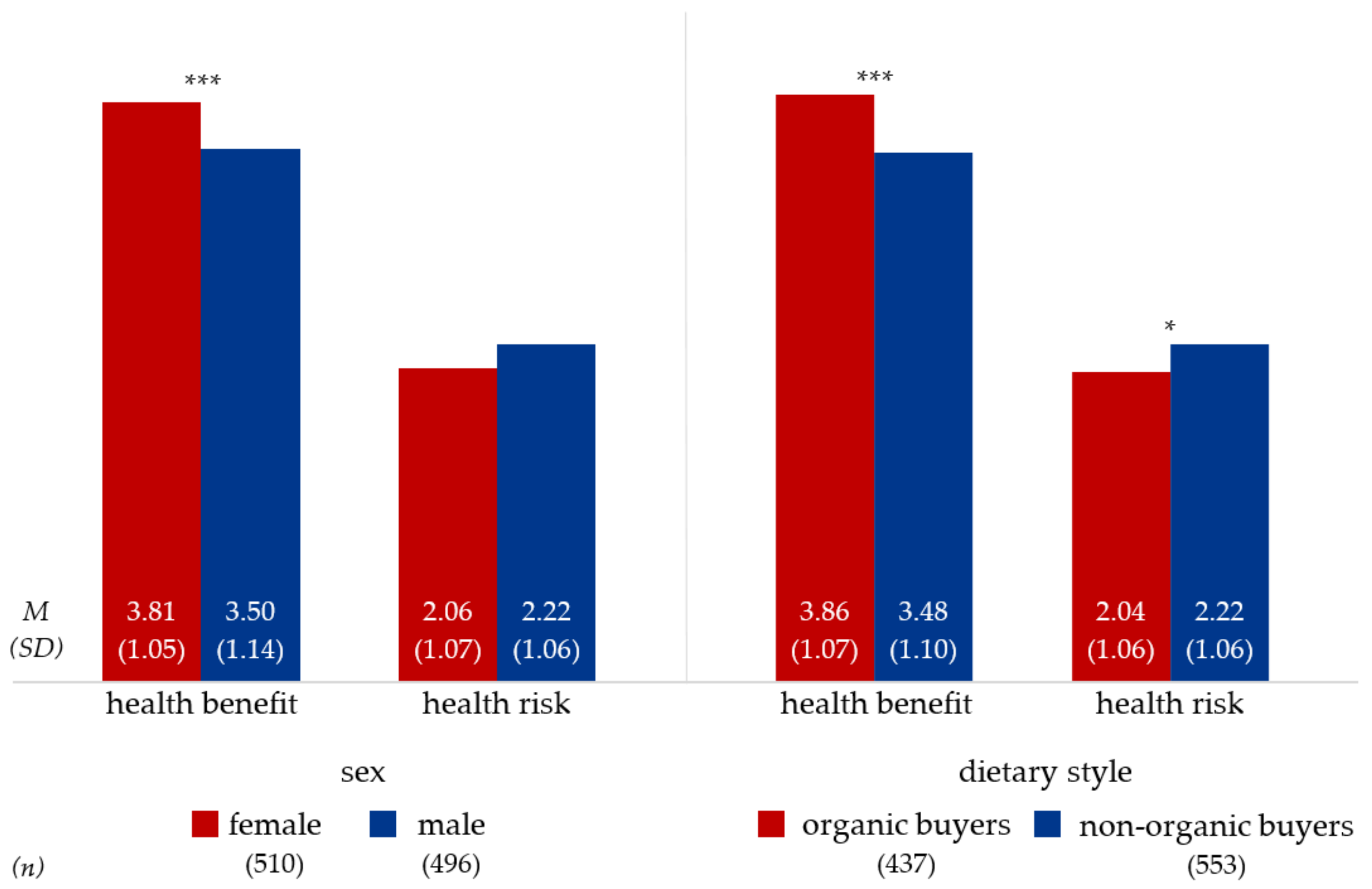The Public’s Understanding of Superfoods
Abstract
:1. Introduction
2. Materials and Methods
2.1. Participants
2.2. Study Design
2.3. Statistical Analysis
3. Results
3.1. Conceptual Understanding of the Term “Superfood”
3.1.1. Awareness of the Term
3.1.2. Associated Properties
3.1.3. Labelling Test
3.2. Consumption Behavior
3.2.1. Consumption Frequency
3.2.2. Reasons for Consumption
3.2.3. Reasons for Non-Consumption
3.3. Risk-Benefit-Appraisal
3.3.1. Rating of Health Benefits Versus Risks
3.3.2. Mentioned Health Benefits
3.3.3. Mentioned Health Risks
4. Discussion
5. Conclusions
Author Contributions
Funding
Institutional Review Board Statement
Informed Consent Statement
Data Availability Statement
Acknowledgments
Conflicts of Interest
References
- IRI. Superfoods Mit Superzahlen [Superfoods with Super Numbers]. 2016. Available online: https://www.iriworldwide.com/de-de/insights/news/superfood-mit-superzahlen (accessed on 14 January 2022).
- Van den Driessche, J.J.; Plat, J.; Mensink, R.P. Effects of superfoods on risk factors of metabolic syndrome: A systematic review of human intervention trials. Food Funct. 2018, 9, 1944–1966. [Google Scholar] [CrossRef] [PubMed]
- Sikka, T. The contradictions of a superfood consumerism in a postfeminist, neoliberal world. Food Cult. Soc. 2019, 22, 354–375. [Google Scholar] [CrossRef]
- Kuchheuser, P.; Jost, S.; Birringer, M. Superfoods im Fokus: Ein kritischer Blick auf Chiasamen und Co [Focus on superfoods: A critical view on chiaseeds and Co]. Aktuelle Ernährungsmedizin 2021, 46, 36–40. [Google Scholar] [CrossRef]
- Regulation (EU) 2015/2283 of the European Parliament and of the Council of 25 November 2015 on Novel Foods, Amending Regulation (EU) No 1169/2011 of the European Parliament and of the Council and Repealing Regulation (EC) No 258/97 of the European Parliament and of the Council and Commission Regulation (EC) No 1852/2001. Available online: https://eur-lex.europa.eu/legal-content/EN/TXT/?uri=celex%3A32015R2283 (accessed on 14 January 2022).
- European Commission. Novel Food Catalogue. Available online: https://ec.europa.eu/food/safety/novel-food/novel-food-catalogue_en (accessed on 14 January 2022).
- Oxford English Dictionary. Superfood. Available online: https://www.oed.com/view/Entry/194186?redirectedFrom=superfood#eid69476470 (accessed on 14 January 2022).
- Proestos, C. Superfoods: Recent data on their role in the prevention of diseases. Curr. Res. Nutr. Food Sci. 2018, 6, 576–593. [Google Scholar] [CrossRef]
- Onneken, P. Salvia hispanica L (chia seeds) as brain superfood: How seeds increase intelligence. Glob. J. Health Sci. 2018, 10, 69–72. [Google Scholar] [CrossRef]
- Jagdale, Y.D.; Mahale, S.V.; Zohra, B.; Nayik, G.A.; Dar, A.H.; Khan, K.A.; Abdi, G.; Karabagias, I.K. Nutritional profile and potential health benefits of super foods: A review. Sustainability 2021, 13, 9240. [Google Scholar] [CrossRef]
- Sargi, S.C.; Silva, B.C.; Santos, H.M.C.; Montanher, P.F.; Boeing, J.S.; Santos Júnior, O.O.; Souza, N.E.; Visentainer, J.V. Antioxidant capacity and chemical composition in seeds rich in omega-3: Chia, flax, and perilla. Food Sci. Technol. 2013, 33, 541–548. [Google Scholar] [CrossRef] [Green Version]
- Singh, S.; Singh, R.; Singh, K.V. Quinoa (Chenopodium quinoa Willd), functional superfood for today’s world: A review. World Sci. News 2016, 58, 84–96. [Google Scholar]
- Ayerza, R. The seed’s protein and oil content, fatty acid composition, and growing cycle length of a single genotype of chia (Salvia hispanica L.) as affected by environmental factors. J. Oleo Sci. 2009, 58, 347–354. [Google Scholar] [CrossRef] [Green Version]
- Mack, L.; Munz, S.; Capezzone, F.; Hofmann, A.; Piepho, H.P.; Claupein, W.; Graeff, S. Sowing date in egypt affects chia seed yield and quality. Agron. Soils Environ. Qual. 2018, 110, 2310–2321. [Google Scholar] [CrossRef]
- Larramendi, C.H.; García-Abujeta, J.L.; Vicario, S.; García-Endrino, A.; López-Matas, M.A.; García-Sedeño, M.D.; Carnés, J. Goji Berries (Lycium barbarum): Risk of allergic reactions in individuals with food allergy. J. Investig. Allergol. Clin. Immunol. 2012, 22, 345–350. [Google Scholar] [PubMed]
- Albunni, B.A.; Wessels, H.; Paschke-Kratzin, A.; Fischer, M. Antibody cross-reactivity between proteins of chia seed (Salvia hispanica L.) and other food allergens. J. Agric. Food Chem. 2019, 67, 7475–7484. [Google Scholar] [CrossRef] [PubMed]
- Jeszka-Skowron, M.; Oszust, K.; Zgoła-Grześkowiak, A.; Frąc, M. Quality assessment of goji fruits, cranberries, and raisins using selected markers. Eur. Food Res. Technol. 2018, 244, 2159–2168. [Google Scholar] [CrossRef] [Green Version]
- Štepec, D.; Tavčar, G.; Ponikvar-Svet, M. Surprisingly high fluorine content in some exotic superfoods. J. Fluor. Chem. 2020, 234, 109521. [Google Scholar] [CrossRef]
- Papadimitriou, T.; Kormas, K.; Vardaka, E. Cyanotoxin contamination in commercial Spirulina food supplements. J. Consum. Prot. Food Saf. 2021, 16, 227–235. [Google Scholar] [CrossRef]
- Mesías, M.; Holgado, F.; Márquez-Ruiz, G.; Morales, F.J. Risk/benefit considerations of a new formulation of wheat-based biscuit supplemented with different amounts of chia flour. LWT Food Sci. Technol. 2016, 73, 528–535. [Google Scholar] [CrossRef] [Green Version]
- Purvis, B.; Mao, Y.; Robinson, D. Three pillars of sustainability: In search of conceptual origins. Sustain. Sci. 2019, 14, 681–695. [Google Scholar] [CrossRef] [Green Version]
- Da Cruz, N.F.; Marques, R.C. Scorecards for sustainable local governments. Cities 2014, 39, 165–170. [Google Scholar] [CrossRef] [Green Version]
- Magrach, A.; Sanz, M.J. Environmental and social consequences of the increase in the demand for ‘superfoods’ world-wide. People Nat. 2020, 2, 267–278. [Google Scholar] [CrossRef]
- Bedoya-Perales, N.S.; Pumi, G.; Talamini, E.; Padula, A.D. The quinoa boom in Peru: Will land competition threaten sustainability in one of the cradles of agriculture? Land Use Policy 2018, 79, 475–480. [Google Scholar] [CrossRef]
- Meyerding, S.; Kürzdörfer, A.; Gassler, B. Consumer preferences for superfood ingredients—The case of bread in Germany. Sustainability 2018, 10, 4667. [Google Scholar] [CrossRef] [Green Version]
- Liu, H.; Meng-Lewis, Y.; Ibrahim, F.; Zhu, X. Superfoods, super healthy: Myth or reality? Examining consumers’ repurchase and WOM intention regarding superfoods: A theory of consumption values perspective. J. Bus. Res. 2021, 137, 69–88. [Google Scholar] [CrossRef]
- Lucas, B.F.; Götze, F.; Costa, J.A.V.; Brunner, T.A. Consumer perception toward “superfoods”: A segmentation study. J. Int. Food Agribus. Mark. 2022, 2022, e2044955. [Google Scholar] [CrossRef]
- Karelakis, C.; Zevgitis, P.; Galanopoulos, K.; Mattas, K. Consumer trends and attitudes to functional foods. J. Int. Food Agribus. Mark. 2020, 32, 266–294. [Google Scholar] [CrossRef]
- Köster, E.P. Diversity in the determinants of food choice: A psychological perspective. Food Qual. Prefer. 2007, 20, 70–82. [Google Scholar] [CrossRef]
- Corallo, A.; Latino, M.E.; Menegoli, M.; Spennato, A. A survey to discover current food choice behaviors. Sustainability 2019, 11, 5041. [Google Scholar] [CrossRef] [Green Version]
- Newman, N.; Fletcher, R.; Levy, D.A.L.; Nielsen, R.K. Reuters Institute Digital News Report 2016. Available online: https://reutersinstitute.politics.ox.ac.uk/sites/default/files/research/files/Digital%2520News%2520Report%25202016.pdf (accessed on 14 January 2022).
- Roth, A.; Zawadzki, T. Instagram as a tool for promoting superfood products. Ann. Mark. Manag. Econ. 2018, 4, 101–113. [Google Scholar] [CrossRef]
- Kantar. Kantar Profiles Audience Network. Available online: https://www.kantar.com/expertise/research-services/panels-and-audiences/kantar-profiles-network (accessed on 14 January 2022).
- Nayak, M.S.D.P.; Narayan, K.A. Strengths and weaknesses of online surveys. J. Humanit. Soc. Sci. 2019, 24, 31–38. [Google Scholar]
- Evans, J.E.; Mathur, A. The Value of Online Surveys. Internet Res. 2005, 15, 195–219. [Google Scholar] [CrossRef]
- U.S. Department of Agriculture. Food Data Central. Available online: https://fdc.nal.usda.gov/ (accessed on 6 January 2022).
- Gopalan, A.; Reuben, S.C.; Ahmed, S.; Darvesh, A.S.; Hohmann, J.; Bishayee, A. The health benefits of blackcurrants. Food Funct. 2012, 3, 795–809. [Google Scholar] [CrossRef]
- Tripathi, V.; Abidi, A.B.; Marker, S.; Bilal, S. Linseed and linseed oil: Health benefits—A review. Int. J. Pharm. Biol. Sci. 2013, 3, 434–442. [Google Scholar]
- Martínez-Villaluenga, C.; Peñas, E. Health benefits of oat: Current evidence and molecular mechanisms. Curr. Opin. Food Sci. 2017, 14, 26–31. [Google Scholar] [CrossRef] [Green Version]
- Shah, T.; Bule, M.; Niaz, K. Goji berry (Lycium barbarum): A superfood. In Nonvitamin and Nonmineral Nutritional Supplements; Nabavi, A.M., Silva, A.S., Eds.; Academic Press: London, UK, 2019; pp. 257–264. [Google Scholar] [CrossRef]
- Rao, J.N.K.; Scott, A.J. On chi-squared tests for multiway contingency tables with cell proportions estimated from survey data. Ann. Statist. 1984, 12, 46–60. [Google Scholar] [CrossRef]
- Long, J.A. jtools: Analysis and Presentation of Social Scientific Data. Available online: https://CRAN.R-project.org/package=jtools (accessed on 15 February 2022).
- Cohen, J. Statistical Power Analysis for the Behavioral Sciences, 2nd ed.; Routledge Academic: New York, NY, USA, 1988. [Google Scholar] [CrossRef]
- Statistisches Bundesamt. Genesis-Online Datenbank 51000-0005: Aus- und Einfuhr (Außenhandel): Deutschland, Jahre, Warensystematik. Available online: https://www-genesis.destatis.de/genesis/online?operation=statistic&levelindex=0&levelid=1632834112865&code=51000#abreadcrumb (accessed on 28 September 2021).
- Lee, C.N.; Loke, M. Local and imported fruits in Hawai‘I from a nutrient perspective. Coll. Trop. Agric. Hum. Resour. 2017, FN-14, 1–11. [Google Scholar]
- Bringezu, S.; Banse, M.; Ahmann, L.; Bezama, N.A.; Billig, E.; Bischof, R.; Blanke, C.; Brosowski, A.; Brüning, S.; Borchers, M.; et al. Pilotbericht zum Monitoring der Deutschen Bioökonomie [Pilot Report on Monitoring the German Bioeconomy]; Center for Environmental Systems Research (CESR): Kassel, Germany, 2020. [Google Scholar] [CrossRef]
- Basha, M.B.; Mason, C.; Shamsudin, M.F.; Hussain, H.I.; Salem, M.A. Consumers attitude towards organic food. Procedia Econ. Financ. 2015, 31, 444–452. [Google Scholar] [CrossRef] [Green Version]
- Reja, U.; Lozar Manfreda, K.; Hlebec, V.; Vehovar, V. Open-ended vs. close-ended questions in web questionnaires. Adv. Methodol. Stat. 2003, 19, 159–177. [Google Scholar]





| Definition | |
|---|---|
| Superfood | The term “superfood” is often used to describe foods that are considered to be particularly beneficial to human health because they are said to contain high contents of nutrients – for example, a high content of vitamins, antioxidants, proteins, minerals, or fiber. Exotic foods in particular are referred to as superfoods. Typical examples of superfood are: chia seeds, quinoa, goji berries, matcha tea, and avocado. |
| Small Effect | Medium Effect | Large Effect | |
|---|---|---|---|
| Cohen’s d | |0.20| | |0.50| | |0.80| |
| Pearson’s r | |0.10| | |0.30| | |0.50| |
| Cramer’s V | 0.10 | 0.30 | 0.50 |
Publisher’s Note: MDPI stays neutral with regard to jurisdictional claims in published maps and institutional affiliations. |
© 2022 by the authors. Licensee MDPI, Basel, Switzerland. This article is an open access article distributed under the terms and conditions of the Creative Commons Attribution (CC BY) license (https://creativecommons.org/licenses/by/4.0/).
Share and Cite
Kirsch, F.; Lohmann, M.; Böl, G.-F. The Public’s Understanding of Superfoods. Sustainability 2022, 14, 3916. https://doi.org/10.3390/su14073916
Kirsch F, Lohmann M, Böl G-F. The Public’s Understanding of Superfoods. Sustainability. 2022; 14(7):3916. https://doi.org/10.3390/su14073916
Chicago/Turabian StyleKirsch, Fabian, Mark Lohmann, and Gaby-Fleur Böl. 2022. "The Public’s Understanding of Superfoods" Sustainability 14, no. 7: 3916. https://doi.org/10.3390/su14073916
APA StyleKirsch, F., Lohmann, M., & Böl, G.-F. (2022). The Public’s Understanding of Superfoods. Sustainability, 14(7), 3916. https://doi.org/10.3390/su14073916






